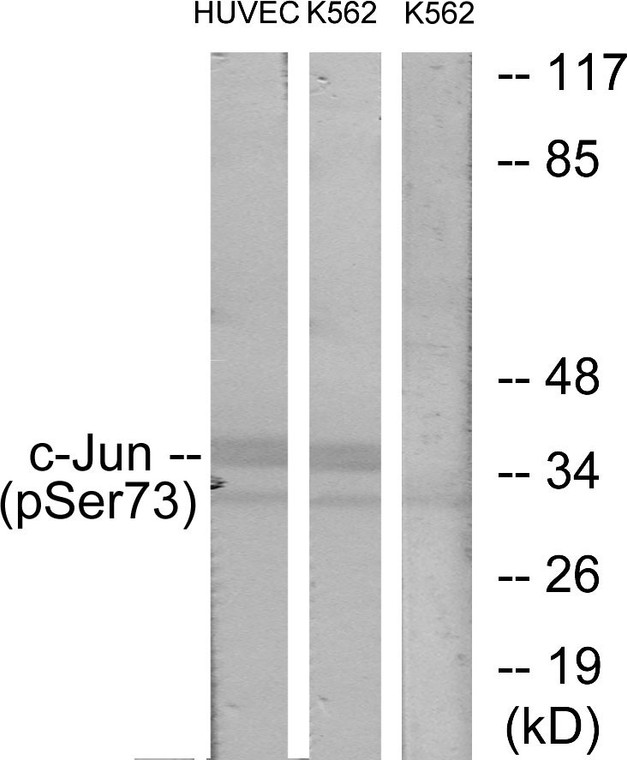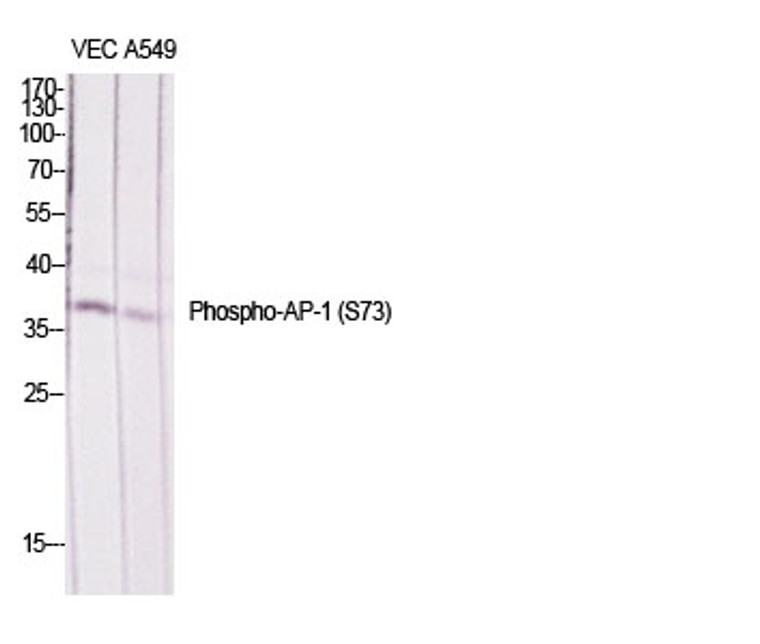| Host: |
Rabbit |
| Applications: |
WB/IHC/IF/ELISA |
| Reactivity: |
Human/Mouse/Rat |
| Note: |
STRICTLY FOR FURTHER SCIENTIFIC RESEARCH USE ONLY (RUO). MUST NOT TO BE USED IN DIAGNOSTIC OR THERAPEUTIC APPLICATIONS. |
| Short Description: |
Rabbit polyclonal antibody anti-Phospho-Transcription factor AP-1 and Transcription factor jun-D-Ser73/100 (40-89 aa) is suitable for use in Western Blot, Immunohistochemistry, Immunofluorescence and ELISA research applications. |
| Clonality: |
Polyclonal |
| Conjugation: |
Unconjugated |
| Isotype: |
IgG |
| Formulation: |
Liquid in PBS containing 50% Glycerol, 0.5% BSA and 0.02% Sodium Azide. |
| Purification: |
The antibody was affinity-purified from rabbit antiserum by affinity-chromatography using epitope-specific immunogen. |
| Concentration: |
1 mg/mL |
| Dilution Range: |
WB 1:500-1:2000IHC 1:100-1:300ELISA 1:10000IF 1:50-200 |
| Storage Instruction: |
Store at-20°C for up to 1 year from the date of receipt, and avoid repeat freeze-thaw cycles. |
| Gene Symbol: |
JUNJUND |
| Gene ID: |
37253727 |
| Uniprot ID: |
JUN_HUMANJUND_HUMAN |
| Immunogen Region: |
40-89 aa |
| Specificity: |
Phospho-AP-1 (S73) Polyclonal Antibody detects endogenous levels of AP-1 protein only when phosphorylated at S73. |
| Immunogen: |
The antiserum was produced against synthesized peptide derived from the human c-Jun around the phosphorylation site of Ser73 at the amino acid range 40-89 |
| Post Translational Modifications | Ubiquitinated by the SCF(FBXW7), leading to its degradation. Ubiquitination takes place following phosphorylation, that promotes interaction with FBXW7. Phosphorylated by CaMK4 and PRKDC.phosphorylation enhances the transcriptional activity. Phosphorylated by HIPK3. Phosphorylated by DYRK2 at Ser-243.this primes the protein for subsequent phosphorylation by GSK3B at Thr-239. Phosphorylated at Thr-239, Ser-243 and Ser-249 by GSK3B.phosphorylation reduces its ability to bind DNA. Phosphorylated by PAK2 at Thr-2, Thr-8, Thr-89, Thr-93 and Thr-286 thereby promoting JUN-mediated cell proliferation and transformation. Phosphorylated by PLK3 following hypoxia or UV irradiation, leading to increase DNA-binding activity. Acetylated at Lys-271 by EP300. |
| Function | Transcription factor that recognizes and binds to the enhancer heptamer motif 5'-TGACGTCA-3'. Promotes activity of NR5A1 when phosphorylated by HIPK3 leading to increased steroidogenic gene expression upon cAMP signaling pathway stimulation. Involved in activated KRAS-mediated transcriptional activation of USP28 in colorectal cancer (CRC) cells. Binds to the USP28 promoter in colorectal cancer (CRC) cells. |
| Protein Name | Transcription Factor Ap-1Activator Protein 1Ap1Proto-Oncogene C-JunV-Jun Avian Sarcoma Virus 17 Oncogene HomologP39 |
| Database Links | Reactome: R-HSA-1912408Reactome: R-HSA-2559580Reactome: R-HSA-2559582Reactome: R-HSA-2871796Reactome: R-HSA-450341Reactome: R-HSA-5617472Reactome: R-HSA-5687128Reactome: R-HSA-6796648Reactome: R-HSA-8862803Reactome: R-HSA-8943724Reactome: R-HSA-9018519Reactome: R-HSA-9673324 |
| Cellular Localisation | Nucleus |
| Alternative Antibody Names | Anti-Transcription Factor Ap-1 antibodyAnti-Activator Protein 1 antibodyAnti-Ap1 antibodyAnti-Proto-Oncogene C-Jun antibodyAnti-V-Jun Avian Sarcoma Virus 17 Oncogene Homolog antibodyAnti-P39 antibodyAnti-JUN antibody |
Information sourced from Uniprot.org
12 months for antibodies. 6 months for ELISA Kits. Please see website T&Cs for further guidance










